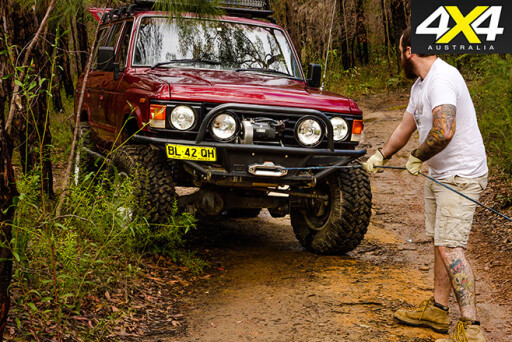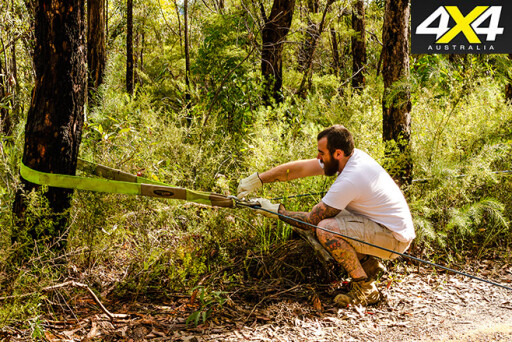
THINGS can and do go wrong. It’s a fact of life in general, but something that’s an ever-present danger when heading off-road. A mis-step, incorrect wheel placement, or just slippery conditions can put your 4x4 in the line of danger within a split second.
It could be something as simple as the front wheels dropping down a ledge, through to a fully loaded camper trailer sliding off the side of the track and threatening to drag you with it. Either way, the results are basically the same: you’re in a bad situation and desperately need to do something pretty fancy to get yourself out of it.
Enter the winch redirection.
The concept is simple enough. A winch fitted to the front of your vehicle can pull you forwards but is next to useless in any other direction. But through the use of pulley blocks, it’s possible to redirect the winch line – much like a multiple line pull – to alter where the pulling power is directed. It’s a skill you may never need to use in your entire off-road career – but that one time, in that one bad situation, it could very well save your life.
WHAT YOU'LL NEED
- Standard recovery kit
- As much rope or cable as possible
- 3 snatch blocks
- 3 tree-trunk protectors
- 3 winch dampers
- 3 rated bow shackles
STEPS
 1. SECURE THE 4X4
1. SECURE THE 4X4
This should always be the first step for any recovery where life or limb is at risk. If you need to perform a sideways winch, chances are your 4x4 is either over or close to the edge of the track. Get everyone out of the vehicle to a safe place out of harms way, and then stabilise it as much as possible before you start working on it. Branches lodged against the wheels can be enough to stop further slipping.
 2. IDENTIFY YOUR WINCH POINTS
2. IDENTIFY YOUR WINCH POINTS
You’ll need two anchor points to perform a basic sideways recovery. Both need to be on the side you want to pull the vehicle towards – one in front of the vehicle and one behind. All the usual rules count; the largest tree will provide the most secure winch point. Look for any wounds or damage that could indicate the tree is in poor shape, as any internal rot will compromise its strength. Don’t be afraid to use winch extension straps if suitable trees are too far away.
 3. RUN OUR THE WINCH LINE
3. RUN OUR THE WINCH LINE
You’ll need a lot of line to do a recovery like this, but that’s good, as the more line you take off the drum, the more torque you have available. Unspool a large amount of line off the drum then begin laying it out how you’ll need it. You’ll need enough to attach the end of the line to the recovery point on the rear of your vehicle and then run through the two anchor points you’ve selected off to the side.
 4. START RIGGING UP THE ANCHOR POINTS
4. START RIGGING UP THE ANCHOR POINTS
Wrap a trunk protector around the tree, then attach a snatch block using a rated bow shackle with the line running through it. Unlike a multiple-line pull, the winch line will go to the next point in the line rather than back where it came from. You’ll need to complete this process on both recovery points. An extension strap can double as a trunk protector, but note that wrapping it around the tree can compress the bark and cut off the tree’s water supply.
 5. PREPARE THE LINE
5. PREPARE THE LINE
When you’re confident you’ve set everything up properly, fit winch dampers to each line – so that’s three at a minimum. A heavy jumper or jacket can double as a damper in a pinch. Then, with all the lines properly damped, pull the line in until it’s tensioned.
 6. BEGIN WINCHING
6. BEGIN WINCHING
With everyone at a safe distance (and an escape plan if things go south) begin winching. As you’ll literally be dragging your tyre sideways across the ground, the load will be high, so follow the 10/30 rule: 10 seconds winching followed by a 30 seconds break, to avoid damaging your battery or overheating your winch motor.
 7. SECURE THE VEHICLE
7. SECURE THE VEHICLE
When your vehicle is on solid ground or at least where you want it, you’ll need to re-secure it before you can back off the winch line. Depending on the terrain, this can be as simple as ensuring it’s in park with the handbrake applied, although chocking the wheels would be recommended.
It might be necessary to re-rig the winch to pull you further up the track before attempting to drive under your own power. After all, if the track was tricky enough to catch you once, you don’t want to let it catch you twice.
After securing the vehicle and backing off the line, do a thorough visual inspection before spooling your line back onto the winch. In recoveries like this it’s easy to miss a stray tree or rock rubbing on the line, which may have cut or damaged it. Depending on the damage, the line can be shortened or spliced to get you out of trouble, although should be replaced as soon as possible.
The sequence below shows how the rear of the vehicle was dragged sideways on to the track, to continue on its way forward.

COMMENTS